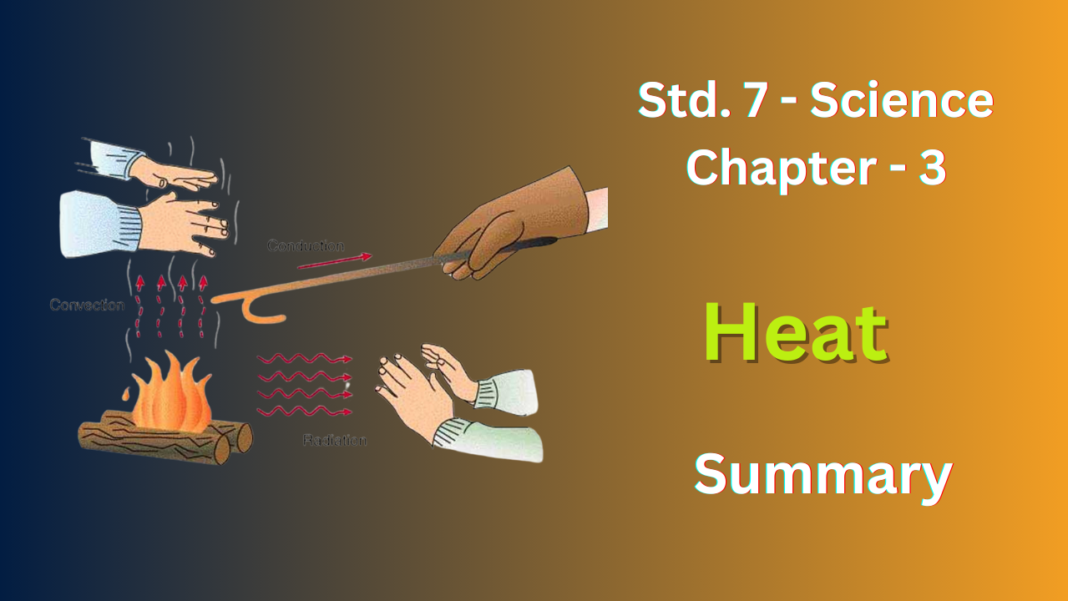NCERT Solutions for Class 7 Science Chapter 3
This chapter is all about heat, the energy that flows between objects due to a temperature difference. Here’s a quick breakdown:
- Heat Transfer: Heat always moves from a hotter object to a cooler one until they reach the same temperature.
- The Three Amigos: There are three main ways travels:
- Conduction: Direct touch! Think of a metal spoon getting hot in hot soup.
- Convection: Movement of fluids (liquids and gases). Hot air rises, cooler air sinks (like sea breezes).
- Radiation: Transfer through electromagnetic waves (like the sun warming you).
- Temperature: This is how hot or cold something is, measured with a thermometer.
- Materials and Heat:
- Conductors: Metals like iron and copper allow heat to pass through easily.
- Insulators: Materials like wood and plastic slow down heat transfer.
- Heat and Everyday Life:
- Cooking: Applying heat to transform food.
- Weather: Uneven heating of Earth’s surface creates wind patterns.
Exercises:
1. State similarities and differences between the laboratory thermometer and the clinical thermometer.
Ans :
Similarities:
- Function: Both instruments measure temperature.
- Basic Construction: They typically share a long, narrow glass tube with a bulb at the end containing a liquid (often mercury, although safer alternatives exist).
- Scale: Both may have a Celsius scale for temperature readings.
Differences:
- Purpose:
- Laboratory Thermometer: Measures the temperature of various objects, often in scientific experiments or industrial settings. They can handle a wider temperature range, typically well below and above human body temperature.
- Clinical Thermometer: Designed specifically to measure human body temperature for medical purposes. They have a more limited range, focusing on the range relevant to human health (around 35°C to 42°C).
- Accuracy: Clinical thermometers are typically designed for higher accuracy in the human body temperature range.
- Special Feature: Clinical thermometers often have a kink in the glass tube near the bulb to prevent the mercury from easily flowing back down after measurement, making them easier to read.
2. Give two examples each of conductors and insulators of heat.
Ans :
Conductors: copper, aluminum, and iron.
Insulators: wood, plastic, and rubber.
3.Fill in the blanks
(a) The hotness of an object is detetmined by its ____________ .
(b) Temperature of boiling water cannot be measured by a ____________ thermometer.
(c) Temperature is measured in degree ____________ .
(d) No medium is required for transfer of heat by the process of ____________.
(e) A cold steel spoon is dipped in a cup of hot milk. It transfers heat to its other end by the process of ____________
(f) Clothes of ___________ colours absorb heat better than clothes of light colours.
Ans :
a)Temperature.
(b) Laboratory
(c) Celsius
(d)Radiation.
(e) Conduction.
(f)Dark
4. Match the following
| Column I | Column II |
| Land breeze blows during | Summer |
| Sea breeze blows during | Winter |
| Dark Coloured clothes are preferred during | Day |
| Light Coloured clothes are preferred during | Night |
Ans :
| Column I | Column II |
| Land breeze blows during | Night |
| Sea breeze blows during | Day |
| Dark Coloured clothes are preferred during | Winter |
| Light Coloured clothes are preferred during | Summer |
5. Discuss why wearing more layers of clothing during winter keeps us warmer than wearing just one thick piece of clothing?
Ans :
- Trapped Air: Air is a poor conductor of heat. This means it doesn’t transfer well. When you wear multiple layers of clothing, air gets trapped between the layers. This layer of trapped air acts like an insulator, slowing down the transfer of heat from your body to the cold environment.
- Dead Air Space: Each layer of clothing creates a small pocket of air around your body. Even the fabric itself traps some air. The more layers you wear, the more dead air space is created, further increasing the insulation effect.
6. Look at figure 4.6. Mark where the heat is being transferred by conduction, by convection and by radiation
Ans :
7. In places of hot climate it is advised that the outer walls of houses be painted white. Explain.
Ans : Paint it white! White walls reflect heat from the sun, keeping your house cooler. Dark colors absorb heat, making things hotter inside. Think mirror (white) vs. sponge (dark) for the sun’s rays!
8. One litre of water at 30°C is mixed with one litre of water at 50°C. The temperature of the mixture will be:
(a) 80°C (b) More than 50°C but less than 80°C
(c) 20°C (d) Between 30°C and 50°C
Ans : The temperature of the mixture will be: (d) Between 30°C and 50°C.
9. An iron ball at 40°C is dropped in a mug containing water at 40°C. The heat will:
(a) flow from iron ball to water.
(b) not flow from iron ball to water or from water to iron ball.
(c) flow from water to iron ball.
(d) increase the temperature of both.
Ans : (b) not flow from iron ball to water or from water to iron ball.
10. A wooden spoon is dipped in a cup of ice-cream. Its other end:
(a) becomes cold by the process of conduction
(b) becomes cold by the process of convection
(c) becomes cold by the process of radiation
(d) does not become cold
Ans : (d) does not become cold.
11.Stainless steel pans are usually provided with copper bottoms. The reason for this could be that:
(a) copper bottom makes the pan more durable
(b) such pans appear colourful
(c) copper is a better conductor of heat than the stainless steel
(d) copper is easier to clean than the stainless steel
Ans : (c) copper is a better conductor of heat than stainless steel.
FAQ’s
What topics are covered in NCERT Class 7 Science Chapter 3?
Chapter 3 of Class 7 Science explores the fundamental concept of “Heat,” covering various aspects such as its sources, effects, and applications.
Can you provide an overview of the concept of “Heat”?
It is a form of energy that results from the movement of particles within a substance. This chapter discusses the sources of heat, methods of heat transfer, and the effects of heat on different materials.
Why is understanding “Heat” important?
Understanding the principles of fireis crucial as it has widespread applications in everyday life, technology, and industry. It influences weather patterns, affects the behavior of materials, and plays a vital role in various scientific phenomena.
How do Class 7 Science Chapter 3 help in learning about this topic?
These solutions provide clear explanations, diagrams, and practical examples to illustrate the concepts related to fire. They cover topics such as conduction, convection, radiation, thermal expansion, and fire transfer mechanisms.
What are some real-life examples of heat discussed in this chapter?
The knowledge gained from studying “Fire” can be applied to various scenarios such as cooking, heating systems, thermal insulation, climate control, and thermal management in electronic devices.
How can Education85 help me study?
Education85 offers NCERT solutions, study guides, and practice materials to support your learning. Our resources cover various subjects and grades, helping you excel in your academics.
Are the resources on Education85 free to access?
Yes, all resources on Education85 are available for free.
How can I navigate through Education85 to find the resources I need?
You can easily navigate through Education85 by using the search bar or browsing through the different categories and subjects.
Are the NCERT solutions on Education85 accurate and reliable?
Yes, our NCERT solutions are created by subject matter experts and are thoroughly reviewed to ensure accuracy and reliability.









